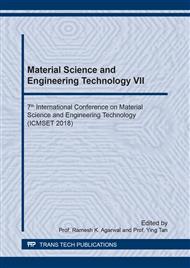[1]
V. E. Buchanan, D. G. McCartney, P. H. Shipway, A comparison of the abrasive wear behaviour of iron-chromium based hardfaced coatings deposited by SMAW and electric arc spraying, Wear 264 (2008) 542-549.
DOI: 10.1016/j.wear.2007.04.008
Google Scholar
[2]
K. Kimapong, P. Poonnayom, V. Wattanjitsiri, Microstructure and Wear Resistance of Hardfacing Weld Metal on JIS-S50C Carbon Steel in Argicultural Machine Parts, Materials Science Forum 872 (2016) 55-61.
DOI: 10.4028/www.scientific.net/msf.872.55
Google Scholar
[3]
A. H. Jones, P. Roffey, The improvement of hard facing coatings for ground engaging applications by the addition of tungsten carbide, Wear 267 (2009) 925-933.
DOI: 10.1016/j.wear.2009.01.042
Google Scholar
[4]
C. Zhang, X. Song, P. Lu, X. Hu, Effect of microstructure on mechanical properties in weld-repaired high strength low alloy steel, Materials & Design 36 (2012) 233-242.
DOI: 10.1016/j.matdes.2011.11.016
Google Scholar
[5]
S. Selvi, S. P. Sankaran, R. Srivatsavan, Comparative study of hardfacing of valve seat ring using MMAW process J. of Mat. Proc. Tech. 207 (2008) 356-362.
DOI: 10.1016/j.jmatprotec.2008.06.053
Google Scholar
[6]
D. Liu, R. Liu, Y. Wei, Y. Ma, K. Zhu, Microstructure and wear properties of Fe–15Cr–2.5Ti–2C–xB wt.% hardfacing alloys, App. Surf. Sci. 271 (2013) 253-259.
DOI: 10.1016/j.apsusc.2013.01.169
Google Scholar
[7]
V. E. Buchanan, P. H. Shipway, D. G. McCartney, Microstructure and abrasive wear behaviour of SMAW hardfacings used in the sugarcane industry, Wear 263 (2007) 99-110.
DOI: 10.1016/j.wear.2006.12.053
Google Scholar
[8]
K. Yang, S. Yu, Y. Li, C. Li, Effect of carbonitride precipitates on the abrasive wear behaviour of hardfacing alloy, App. Surf. Sci. 254 (2008) 5023-5027.
DOI: 10.1016/j.apsusc.2008.01.154
Google Scholar
[9]
X. H. Wang, F. Han, X. M. Liu, S. Y. Qu, Z. D. Zou, Effect of molybdenum on the microstruc. and wear resist. of Fe-based hardfacing coatings, Mat. Sci. and Eng. : A 489 (2008) 193-200.
DOI: 10.1016/j.msea.2007.12.020
Google Scholar
[10]
A. Gualco, H. G. Svoboda, E. S. Surian, L. A. d. Vedia, "Effect of welding procedure on wear behav. of a modified martensitic tool steel hardfac. deposit, Mat. & Des. 31 (2010) 4165-4173.
DOI: 10.1016/j.matdes.2010.04.026
Google Scholar
[11]
R. A. Jeshvaghani, E. Harati, M. Shamanian, Effects of surface alloying on microstructure and wear behavior of ductile iron surface-modified with a nickel-based alloy using shielded metal arc welding, Mat. & Des. 32 (2011) 1531-1536.
DOI: 10.1016/j.matdes.2010.10.006
Google Scholar
[12]
J. J. Coronado, H. F. Caicedo, A. L. Gómez, The effects of welding processes on abrasive wear resistance for hardfacing deposits, Tribology International, 42 (2009) 745-749.
DOI: 10.1016/j.triboint.2008.10.012
Google Scholar
[13]
K.C. Tsai, S.L. Jeng, J.Y. Huang, Prevention of delayed cracking of iron based hardfacing welds, Engineering Failure Analysis 48 (2015) 210-217.
DOI: 10.1016/j.engfailanal.2014.11.025
Google Scholar
[14]
S. Chatterjee, T.K. Pal, Weld procedural effect on the performance of iron based hardfacing deposits on cast iron substrate, J. of Mat. Proc. Tech. 173 (2006) 61-69.
DOI: 10.1016/j.jmatprotec.2005.10.025
Google Scholar
[15]
N. Yüksel, S. Şahin, Wear behavior–hardness–microstructure relation of Fe–Cr–C and Fe–Cr–C–B based hardfacing alloys, Mat. & Des. 58 (2014) 491-498.
DOI: 10.1016/j.matdes.2014.02.032
Google Scholar
[16]
A. Gualco, H.G. Svoboda, E.S. Surian, Study of abrasive wear resistance of Fe-based nanostructured hardfacing, Wear 360–361 (2016) 14-20.
DOI: 10.1016/j.wear.2016.04.011
Google Scholar
[17]
Y. Wu, Y. Cai, H. Wang, S. Shi, X. Hua, Y. Wu, Investigation on microstructure and properties of dissimilar joint between SA553 and SUS304 made by laser welding with filler wire, Mat. & Des. 87 (2015) 567-578.
DOI: 10.1016/j.matdes.2015.08.076
Google Scholar


